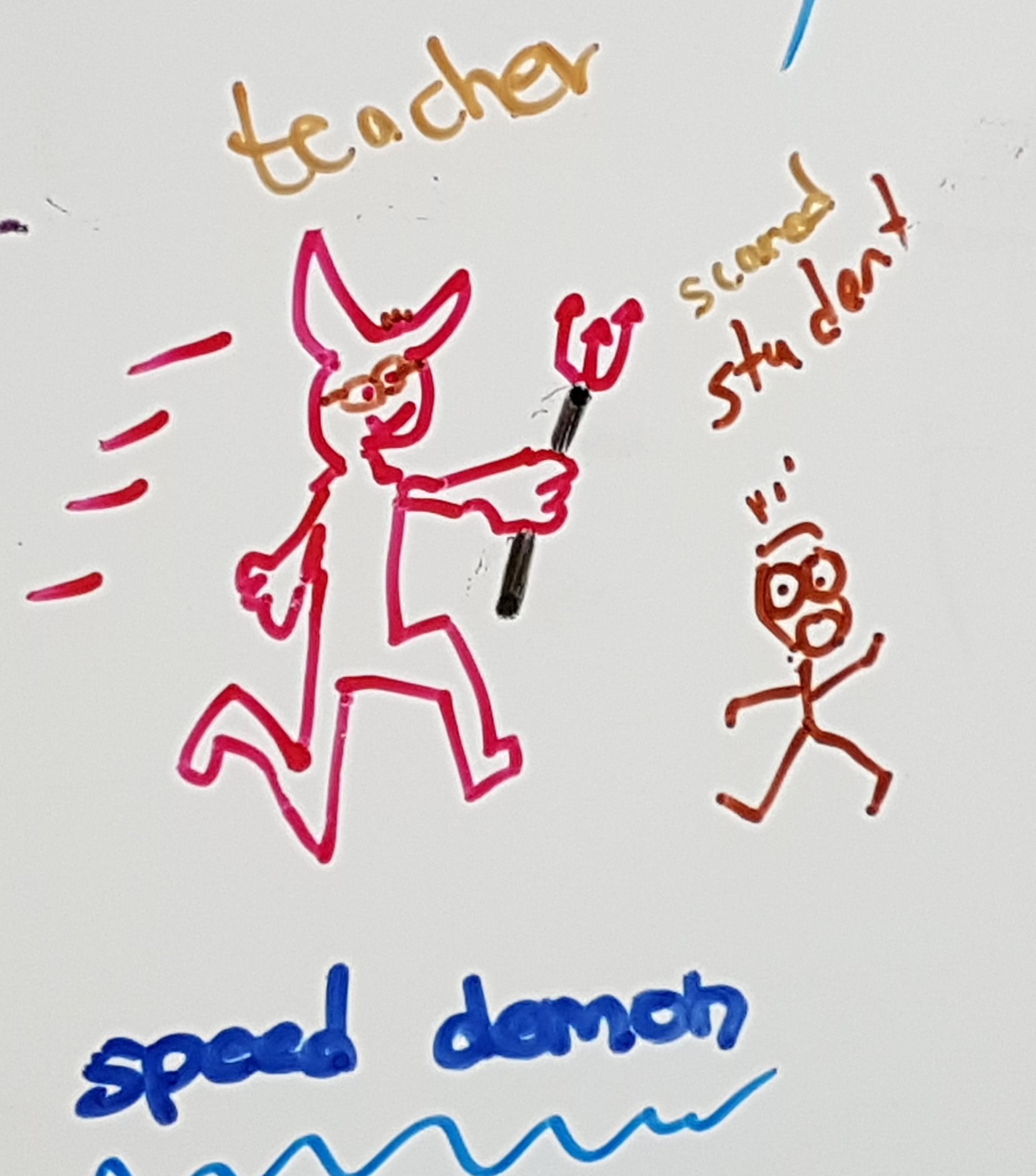I was explaining the term "speed demon" to some students this morning. I drew a pink "speed demon" on the whiteboard." Later, a student amended the drawing, adding glasses and the name "Teacher" to the speed demon, and adding "scared" to the student.
I asked if the teacher was me. She said no, it was just an average teacher.
[daily log: walking, 7km]


I am not sure what people mean, exactly, when they say “speed demon,” and to different people it may mean slightly different things, depending on generation, maybe.
The dictionary says it is a Americanism, and I find from the Google Ngram corpus that it was likely coined in the 1900-1913 period (with the early rise of the automobile at the time, presumably not coincidentally). Its highest single-year usages were 1917, 1933, 1943, 1945, 1947, 1948, 1954, 1962 (and several more following its re-popularization in the 1990s), all of which double or triple the base usage rate of usage from the 1920s to present.
Ngram data for “Speed Demon”:
1913: First recorded use in the Google Books American English (AE) corpus: 1913. http://tinyurl.com/z7kbzgd
1929: First recorded use in the Google Books British English (BE) corpus: 1929. http://tinyurl.com/jesd5qu
At its BE peak, late 1940s to early 1950s, “speed demon” made appearances at a rate one quarter the rate in the AE corpus; at all other times after it begins appearing in BE (1930s on), the BE rate seems around one tenth the AE rate.
Following a huge jump in usage in 1917, the phrase stabilized by 1920 at a rate we can consider the base rate, as it is near the rate for the next century (i.e., to the present day).
Relative frequencies, roughly, for “speed demon” in the AE Corpus (Smoothed for decades; non-smoothed for individual years to identify peaks):
1912: 0
1920: 100
1930s: 135
1940s: 200
1943: 265 (a peak year)
1950s: 170
1954: 290 (a peak year)
1960s: 100
1970s: 100
1980: 100
1990: 200
2000: 275
2003: 335 (the highest-ever peak year)
2008: 275 (last year of Ngram)
My personal impression was that the phrase was a bit old fashioned (I will have first heard it in the early 1990s), but the data says that at that very time it was rising steadily — its renewal began in the early 1980s and continued through the late 1990s, reaching its highest usage frequency ever by the 2000s, and staying high.
This raises a few ‘linguistic’ questions, among which are:
(1) Why did the phrase take off in the 1910s? (“the automobile” is not a full answer, by which I mean that while is the technological context in which the phrase emerged, but why did “speed demon” gain popularity and win out over or push out similar phrases?);
(2) What caused the phrase to stay in the language, and not to fall away and become, as so many now-forgotten slang words/phrases do, ‘era specific’, to be subsequently not used, or used ironically only, or used to specifically and deliberately recall the era of popularization (e.g. 1960s’ “groovy”);
(3) What caused the renewed rise in usage in the 1940s, the clearest trend in the smoothed Ngram data? What caused its decline in the late 1950s?
(4) What caused the renewed rise in the 1980s? (
For questions three and four, I would suggest that the answer is U.S. militarization, and further that this essentially explains the phrase itself over the past century. In the early 1940s, the phrase rode the coattails of cultural militarization in the gear-up to fight Japan and Germany and then the total mobilization for that fight through 1945, and then U.S. pursuit of global military commitments from the late 1940s.
Note that 1930, 1937, and 1938 were low-ebb years for “speed demon” in the AE corpus, and also years that isolationism prevailed in political discourse. On the scale used above (1920=100), the phrase would get only 35 for 1930 and 80 for 1937-1938, respectively, soon taking off, from 1939, to reach about 265 by the key war year of 1943 and staying high over the next decade.
The initial take-off of “speed demon” occurred in 1917, during the U.S. militarization for WWI. The USA’s key war year of 1917. This was just four years after the phrase’s first ever appearance in the corpus.
This narrative seems consistent and confirmed by its highest-ever usage year being 2003, the year of the then-popular Iraq Invasion and the pro-military sentiment following Sept 11 2001]
We also see, in more-or-less the eras of most ‘pacifism’ and/or disgruntlement with U.S. militarization, the lowest sustained usage rate (1960s-1970s).
Is there an alternative explanation? It does seems that “speed demon” owes its life, and survival through the years, principally to U.S. militarization.